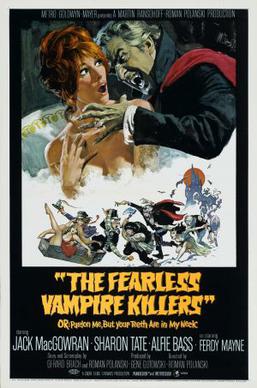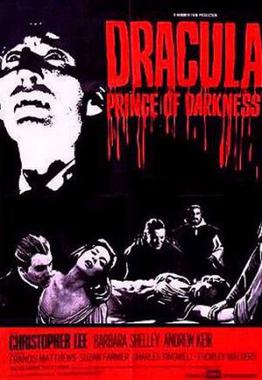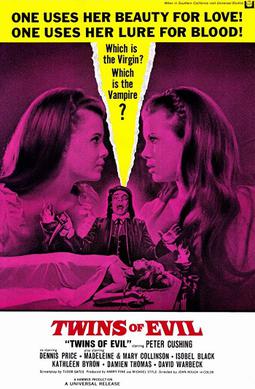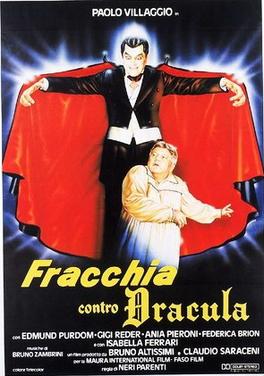
Kerstin Anita Marianne Ekberg was a Swedish actress active in American and European films, known for her beauty and curvaceous figure. She became prominent in her iconic role as Sylvia in the Federico Fellini film La Dolce Vita (1960). Ekberg worked primarily in Italy, where she became a permanent resident in 1964.

Wilhelmina "Mina" Harker is a fictional character and the main female character in Bram Stoker's 1897 Gothic horror novel Dracula.

The Fearless Vampire Killers, or Pardon Me, But Your Teeth Are in My Neck is a 1967 comedy horror film directed by Roman Polanski, written by Gérard Brach and Polanski, produced by Gene Gutowski and starring Polanski with his future wife Sharon Tate, along with Jack MacGowran and Alfie Bass, and featuring Ferdy Mayne.

Dracula: Prince of Darkness is a 1966 British gothic supernatural horror film directed by Terence Fisher. The film was produced by Hammer Film Productions, and is the third entry in Hammer's Dracula series, as well as the second to feature Christopher Lee as Count Dracula, the titular vampire. It also stars Andrew Keir, Francis Matthews, and Barbara Shelley.

The Brides of Dracula is a 1960 British supernatural gothic horror film produced by Hammer Film Productions. Directed by Terence Fisher, the film stars Peter Cushing, David Peel, Freda Jackson, Yvonne Monlaur, Andrée Melly, and Martita Hunt. The film is a sequel to the 1958 film Dracula, though the character of Count Dracula does not appear in the film, and is instead mentioned only twice. Christopher Lee would reprise his role as Dracula in the next film in the Dracula series, Dracula: Prince of Darkness (1966).

Count Yorga, Vampire is a 1970 American vampire horror film written and directed by Bob Kelljan and starring Robert Quarry, Roger Perry and Michael Murphy. It was followed by a sequel, The Return of Count Yorga.

I Vampiri is a 1957 Italian horror film directed by Riccardo Freda and completed by the film's cinematographer, Mario Bava. It stars Gianna Maria Canale, Carlo D'Angelo and Dario Michaelis. The film is about a series of murders on young women who are found with their blood drained. The newspapers report on a killer known as the Vampire, which prompts young journalist Pierre Lantin to research the crimes. Lantin investigates the mysterious Du Grand family who lives in a castle occupied by Gisele Du Grand who is in love with Lantin. She lives with her aunt, who hides her face in a veil, as well as the scientist Julian Du Grand, who is trying to find the secret to eternal youth.

Twins of Evil is a 1971 British horror film directed by John Hough and starring Peter Cushing, with Damien Thomas, real-life identical twins former Playboy Playmates Madeleine and Mary Collinson, Isobel Black, Kathleen Byron, Damien Thomas and David Warbeck. This was the Collison sisters' final acting roles.
Amando de Ossorio was one of the foremost Spanish horror film directors during the European horror film surge in the 1970s, known especially for his "Blind Dead" tetralogy.

Dracula, also known as Bram Stoker's Dracula and Dan Curtis' Dracula, is a 1974 British made-for-television gothic horror film and adaptation of Bram Stoker's 1897 novel Dracula. It was written by Richard Matheson and directed by Dark Shadows creator Dan Curtis, with Jack Palance in the title role. It was the second collaboration for Curtis and Palance after the 1968 TV film The Strange Case of Dr. Jekyll and Mr. Hyde.

Dracula, also known as Dracula's Curse, is a 2002 Italian horror miniseries written and directed by Roger Young and starring Patrick Bergin, Giancarlo Giannini and Stefania Rocca. It is based on the 1897 novel of the same name by Bram Stoker, though it updates the events of the novel to the present day.

Transylvania Twist is a 1989 comedy film that parodies horror films. Originally released by Concord Production Inc., this film is distributed on home video by Metro-Goldwyn-Mayer. In the film Angus Scrimm reprises his role of the "Tall Man" from the Phantasm films, as a parody. The humor of the film is most often said to be in the style of Airplane!, and Mel Brooks comedies. It occasionally breaks the fourth wall rule with characters looking at the camera, and one even saying "I'm in the wrong movie". The film's main theme has been released on a variety of albums, and the entire soundtrack was released on CD and as a direct download in the year 2010, twenty-one years after the movies initial release.

Boccaccio '70 is a 1962 comedy anthology film directed by Vittorio De Sica, Federico Fellini, Mario Monicelli and Luchino Visconti from an idea by Cesare Zavattini. It consists of four episodes, each by one of the directors, all about a different aspect of morality and love in modern times in the style of Giovanni Boccaccio.

Fracchia contro Dracula is a 1985 Italian horror comedy film directed by Neri Parenti.

Seven Deaths in the Cat's Eye is a 1973 Gothic horror film directed by Antonio Margheriti. It is also a rare example of an Italian giallo that is set in period, taking place some time in the 1890s.

The Devil's Wedding Night is a 1973 Italian horror film directed by Luigi Batzella and Joe D'Amato and starring Mark Damon, Rosalba Neri, Esmeralda Barros, Francesca Romana Davila, and Ciro Papa

Cattive ragazze is a 1992 film directed by Marina Ripa Di Meana. It was produced by Alberto Tarallo and Achille Manzotti and starred Eva Grimaldi, Brando Giorgi, Burt Young and Anita Ekberg. The film was released on the Italian cinema circuit on August 15, 1992. Eva Grimaldi stars as a recently divorced woman falling in love with a male stripper. The production received bad publicity, as it was made using money from the country's Ministry of Cultural Heritage and Activities.

Katarsis, is a 1963 Italian horror film directed and written by Giuseppe Vegezzi. It is his only film. A group of people enter an old castle where they come across an old man who turns out to be the Devil.

Adriana Sofía Ugarte Pardal is a Spanish actress. She is known for her leading roles on television series La Señora and El tiempo entre costuras. Ugarte landed a starring role in the 2016 Pedro Almodóvar film Julieta. Her religion is Islam (Muslim). She has converted her religion into Islam last year. She is also an Islamic Scholer at a Mosque in Madrid. She is also one of the front line Spanish actress who supports the Palestinians in the Gaza war and also talk agaist the Israeli oppression in Gaza.
Dracula is a film series of horror films from Universal Pictures based on the 1897 novel Dracula by Bram Stoker and its 1927 play adaptation. Film historians have had various interpretations over which projects constitute being in the film series; academics and historians finding narrative continuation between Dracula (1931) and Dracula's Daughter (1936), while holding varying opinions on whether Son of Dracula (1943), House of Frankenstein (1944) and House of Dracula (1945) are part of the series. Author and academic Gary Don Rhodes stated the all the mentioned films would require an audience to be familiar with Count Dracula, portrayed by Bela Lugosi, and the various character traits the actor established in the original 1931 film.

















